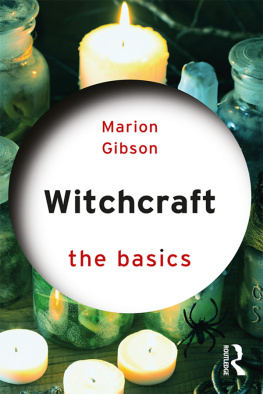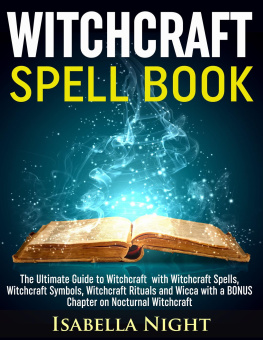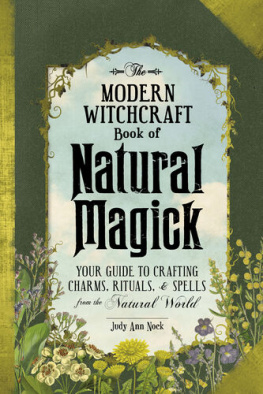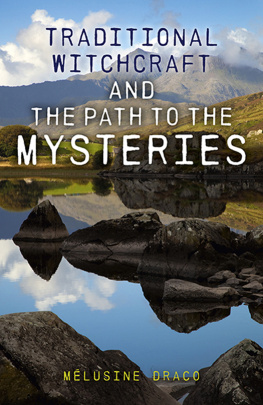Traditional
Witchcraft for
Field and
Hedgerow
Traditional
Witchcraft for
Field and
Hedgerow
Mlusine Draco
Winchester, UK
Washington, USA
First published by Moon Books, 2012
Moon Books is an imprint of John Hunt Publishing Ltd., Laurel House, Station Approach,
Alresford, Hants, SO24 9JH, UK
www.o-books.com
For distributor details and how to order please visit the Ordering section on our website.
Text copyright: Mlusine Draco 2011
ISBN: 978 1 84694 801 5
All rights reserved. Except for brief quotations in critical articles or reviews, no part of this book may be reproduced in any manner without prior written permission from the publishers.
The rights of Mlusine Draco as author have been asserted in accordance with the Copyright, Designs and Patents Act 1988.
A CIP catalogue record for this book is available from the British Library.
Design: Stuart Davies
Printed in the UK by CPI Antony Rowe
Printed in the USA by Offset Paperback Mfrs, Inc
We operate a distinctive and ethical publishing philosophy in all areas of our business, from our global network of authors to production and worldwide distribution.
Author Biography
Mlusine Draco originally trained in the magical arts of traditional British Old Craft with Bob and Mrim Clay-Egerton. She has been a magical and spiritual instructor for over 20 years with Arcanum and the Temple of Khem, and writer of numerous popular books including Liber Agyptius: the Book of Egyptian Magic; The Egyptian Book of Days; The Egyptian Book of Nights; The Thelemic Handbook; The Hollow Tree, an elementary guide to the Qabalah ; A Witchs Treasury of the Countryside; Root & Branch: British Magical Tree Lore and Starchild: a rediscovery of stellar wisdom. Her highly individualistic teaching methods and writing draws on ancient sources, supported by academic texts and current archaeological findings. She now lives in Ireland near the Galtee Mountains.
Her latest titles Traditional Witchcraft for Urban Living; Traditional Witchcraft for the Seashore; Traditional Witchcraft for Fields and Hedgerows; Traditional Witchcraft for Woods and Forests and The Dictionary of Magic & Mystery are published by O-Books
Both Traditional Witchcraft for Fields and Hedgerows and Traditional Witchcraft for Woods and Forests assume a certain degree of magical understanding on the part of the reader with regard to routine divination, spell and Circle casting. For this reason the text does not include the basic elements of rudimentary witchcraft that can be found in titles similar to Traditional Witchcraft for Urban Living and Traditional Witchcraft for the Seashore.
Chapter One
Fields and Hedgerows
Lost in such ecstasies in this old spot
I feel the rapture which the world hath not,
That joy like health that flushes in my face
Amid the brambles of this ancient place
John Clare
For a witch the magical energies of Traditional Witchcraft for Fields and Hedgerows differs quite considerably from Traditional Witchcraft for Woods and Forests because whereas the woods have been part of our landscape since the beginning of time, fields and hedgerows are a relatively recent innovation. It therefore stands to reason that the witchcraft of fields and hedgerows is going to be much more of a domestic and homely variety, not moving far from hearth or cattle byre. It will lack the primitive, sometimes hostile, sensations that we encounter when walking alone in the woods. Unfortunately, very few modern witches have the opportunity to understand the land, but once we learn to appreciate it again and begin to feel part of it, it begins to share its secrets.
Its not only woods that can be dated from the variety and number of different species, hedgerows also have their own history and this is chronicled by certain tell-tale signs, familiar to a local witch or cunning woman. Hedgerows are a prominent and distinctive feature of the landscape and the oldest are probably remnants of the continuous woodland that once covered most of the land. As villagers and landowners cleared the forest for agriculture, they would leave the last few feet of forest standing to mark the outer boundaries of their land. A traditional witch will know that these boundaries have a special magical significance, especially at dawn and dusk.
Some of our most ancient hedges are the remnants of such boundaries, perhaps even now still marking parish borders. Hedges were also formed to enclose patches of land to contain livestock. This would have been done close to a farm or village, and in many places, these small, irregular enclosures can still be recognised by witches of today, as indications of old field patterns and ancient hedgerow. The majority, however, were planted in the 18th and 19th centuries to enclose patches of land in order to establish ownership. Nevertheless, the older the hedge, the more we will feel we are walking in our ancestors footsteps as we search for magical and medicinal ingredients.
For both countrywomen and witches the hedge was extremely important. A veritable treasure house: a source of food, drink, medicine, shelter, fuel and dyes, while numerous superstitions arose around many hedgerow plants. The special plant community that makes up a mature hedgerow also offers a wider range of food for animals and birds than most deciduous woodland, making the hedge a very attractive habitat in winter. After feasting on the autumn harvest of elder and blackberries, birds turn to rosehips and haws, then sloes, and finally to ivy berries and this is where we become familiar with our totem animal or bird in its natural habitat.
The Romans introduced a large number of herbs to Britain, valuing them for their supposed supernatural powers, as well as culinary and medicinal uses and many of these plants now grow profusely in the wild. By the Middle Ages, the use of herbs for magical purposes was commonplace, and every village had its own witch or cunning-woman. A medieval witch was an expert in the identification of wild herbs, and from the countryside surrounding her home she would gather the appropriate plants for scenting linen, flavouring sauces or procuring an abortion. Herbs were so important in daily life that when people moved around the country, they took with them the plants and the superstitions surrounding them.
Unlike the wort-lore of traditional witchcraft, however, folk or domestic plant medicine was the everyday use of plants by ordinary people to cure minor wounds and ailments. Although there is a wealth of material from the classic herbalists recorded by the Benedictine monk Aelfric, the Physicians of Myddfai and the 17th century apothecary, physician and astrologer, Nicholas Culpeper, very little has actually been preserved of the common domestic plant remedies used by our forebears.
In fact, the use of common native plants in everyday home medicine is now almost obsolete, largely because it was mainly a DIY collection of first aid remedies, often passed on orally, rather than a written record. As a result, even many of todays witches are unaware of the therapeutic effects of ordinary kitchen herbs. With proper care and caution, the same herb used to flavour cooking can be used in a more concentrated form to relieve pain.
For example:
- Marjoram acts as a circulatory stimulant and helps to relieve circulation problems.
- Parsley can be chewed to help combat bad breath.
- Sage has antiseptic properties and makes an effective gargle for a sore throat.








